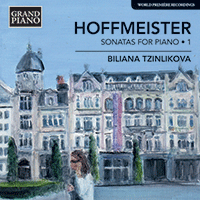
About this Release
VANHAL, JOHANN BAPTIST (1739–1813)
Keyboard Capriccios
- Michael Tsalka, piano
One of the leading composers of the Classical and early Romantic eras, Vanhal played a vital role in the development of Viennese music between 1750 and 1780. He composed prolifically in many genres, including a large number of quartets, symphonies, sacred works, vocal and instrumental works. Vanhal was at his most inspirational and improvisational in his keyboard Capriccios composed in the 1780s, which are some of the most creative examples of the Viennese Classical style, not least in their almost symphonic force.
This recording was made on a modern instrument: Yamaha Grand Piano.
Tracklist
|
3 Neue Caprice-Sonaten, Op. 31: No. 1 in F Major, "Clementis and Silentis" () (00:09:59 )
|
|
1
I. Adagio - Allegro (00:05:28)
|
|
2
II. Andante (00:01:47)
|
|
3
III. Allegro molto (00:02:46)
|
|
3 Neue Caprice-Sonaten, Op. 31: No. 2 in G Minor, "Amoroso" () (00:15:16 )
|
|
4
I. Adagio - Allegro moderato (00:07:45)
|
|
5
II. Andante (00:04:01)
|
|
6
III. Allegretto (00:03:30)
|
|
3 Neue Caprice-Sonaten, Op. 31: No. 3 in F Minor, "Dolente" () (00:12:07 )
|
|
7
I. Adagio - Allegro (00:04:50)
|
|
8
II. Adagio (00:03:09)
|
|
9
III. Allegro (00:04:05)
|
|
3 Caprices, Op. 36: No. 1 in G Major () (00:14:32 )
|
|
10
I. Adagio - Allegro moderato (00:08:05)
|
|
11
II. Andantino (00:04:21)
|
|
12
III. Allegretto (00:02:09)
|
|
3 Caprices, Op. 36: No. 2 in E-Flat Major () (00:13:51 )
|
|
13
I. Adagio - Allegro moderato (00:08:44)
|
|
14
II. Rondo: Allegro (00:05:07)
|
|
3 Caprices, Op. 36: No. 3 in G Minor () (00:14:07 )
|
|
15
I. Adagio - Allegro moderato (00:06:27)
|
|
16
II. Rondo: Allegro (00:07:45)
|
The Artist(s)
The Composer(s)
 Wanhals life may be divided into five periods. The first lasted from his birth as a bonded servant on 12 May 1739 in the Bohemian village of Nechanicz until he moved to Vienna to begin his career in 1760 or 1761. During these twenty years he received excellent training from fine teachers in several Bohemian towns and villages so that he became an accomplished violinist and organist, and a composer of both instrumental and church music. At the same time he prepared himself for a move to Vienna by learning to speak German. His attractive personal characteristics (happy, modest, honest, personal warmth, good looks, personal deportment, deeply religious, etc.) together with his pragmatic and independent spirit foretold his later success.
Wanhals life may be divided into five periods. The first lasted from his birth as a bonded servant on 12 May 1739 in the Bohemian village of Nechanicz until he moved to Vienna to begin his career in 1760 or 1761. During these twenty years he received excellent training from fine teachers in several Bohemian towns and villages so that he became an accomplished violinist and organist, and a composer of both instrumental and church music. At the same time he prepared himself for a move to Vienna by learning to speak German. His attractive personal characteristics (happy, modest, honest, personal warmth, good looks, personal deportment, deeply religious, etc.) together with his pragmatic and independent spirit foretold his later success. Reviews
“Michael Tsalka clearly understands Vanhal’s music. He effectively communicates the humor of the faster movements and plays the more lyrical passages with a singing tone and subtle flexibility of tempo and phrasing.” – Fanfare

“Accolades are due pianist Michael Tsalka, who writes his own excellent notes and plays with feeling, expressivity, and pixieish good humor.” – American Record Guide





 Grand Piano has gained a reputation for producing high quality recordings of rare keyboard gems. Dedicated to the exploration of undiscovered piano repertoire, the label specialises in complete cycles of piano works by many lesser-known composers, whose output might otherwise have remained unknown and unrecorded.
Grand Piano has gained a reputation for producing high quality recordings of rare keyboard gems. Dedicated to the exploration of undiscovered piano repertoire, the label specialises in complete cycles of piano works by many lesser-known composers, whose output might otherwise have remained unknown and unrecorded.






